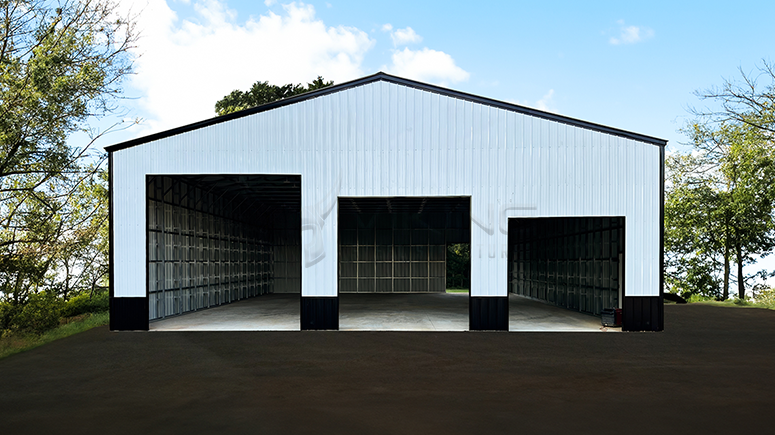There are many practical considerations that you must consider when building a new prefab warehouse. From firm ground with good soil quality and better drainage to budgeting, with proper planning, you can make things simpler. Here, we will provide some tips for constructing a warehouse for a successful project.
7 Steps To Build Your Ideal Metal Warehouse Building
We will start with planning and designing essentials that you must consider. Then, we will move on to budgeting, material selection, and post-construction review of your warehouse prefabricated building. Let’s begin.
1. Basic Planning For Steel Warehouse Building
Define Your Needs: Do you need a warehouse for storage, manufacturing, office space, or something else? Having a clearly defined primary need will let you set a budget, choose the dimensions, and plan the design practically & easily.
Consider Future Expansion: Will you need to expand this building in the future? If so, consider removing end walls while planning your warehouse, as it will be easy to expand in the future.
Ask For Professional Help: To plan a metal prefab warehouse for large-scale projects, you can get help from architects, engineers, and contractors.
2. Designing Warehouse Building
Determine Size & Capacity: What size building do you need? For a small retail space, you can choose a 48x32x14 commercial building to start a boutique shop, convenience store, or specialty store, while for a large showroom, you can pick a 6000 sq. ft. commercial structure to accommodate all wheels.
Choose Clear Span Vs. Multi Span: For manufacturing or processing facilities, you can choose a clear span design that comes without any internal obstructing columns or walls for up to 300 ft. width. For goods & products storage and shipping or distribution center, you can opt for a multi-span design that can be as wide as 600 ft.
Select A Location: Consider the real estate cost, proximity to local infrastructure like roads, utilities, internet connectivity, and access to transportation for efficient logistics. Choose a location with better drainage and space for future expansion.
3. Permits & Regulations For Metal Warehouse Building
Check The Permit Process: Be sure to check the local permit process, such as what type of documentation you will need and a timeline for its approval, and comply with all local building codes to avoid legal setbacks.
Check Local Building Codes & Zoning Laws: Some local regulations may ask you to select a prefab metal warehouse design that can withstand loads of stored goods, snow, wind, and seismic activity. Ensure to add fire safety measures like sprinkler systems, smoke detectors, and fire alarms.
Choose The Right Material: Some local codes may ask you to include energy efficiency and environmentally friendly materials like 100% galvanized steel warehouse for your business. We suggest opting for a 12 gauge thickness steel for frames and a 26 gauge thickness for metal panels for higher durability & longevity.
4. Do Proper Budgeting For Your Warehouse Steel Building
Get An Estimate Cost Of Installation: Based on the location, size, and design complexity of your metal warehouse design, you can set up an estimated cost of installation. Include site preparation, landscaping, and local labor rates as well.
Explore Financing Options: Suppose you want a warehouse for managing e-commerce storage & distribution centers, such as this 60x65x16 metal building would be ideal to start & will cost about $90K. Here, you may need a financing option for easy payments. You can compare interest rates, terms, and eligibility criteria to find the best option for you.
Set A Realistic Budget: Include all potential costs and expenses when constructing a metal warehouse structure. The cost may include factors such as:
- Site preparation
- Permits & architect fees
- Raw material costs
- Construction costs
- Labor charges
- Utilities permit & setup
- Insurance fees
- Contingency fund
A realistic budget is necessary for a successful & stress-free warehouse construction project.
5. Construction Process Of Warehouse Metal Structure
Prepare Site: Start by removing rocks, boulders, & cleaning vegetation from the installation site. Since metal warehouses are large & heavy structures, it is best to hire a soil inspector for grading & help you choose the correct foundation with the right deeper & thickness.
Foundation Choices: Prefab metal buildings can be installed on leveled ground, gravel beds, asphalt, and concrete slabs with variable thickness. However, a concrete slab with a 4 – 8-inch thick is more suitable as it can bear more load, lasts longer, & is highly durable.
Tip: Let the concrete foundation cure for at least 28 days before beginning the construction for maximum durability.
Erect The Metal Framing: Once you are done with laying the foundation, you can start attaching anchors and base rails to the foundation, then add leg posts and the rest of the frame. It is best to choose a vertical roof metal building as it’s more durable against all weather conditions. Ensure to add purlins to support vertical roofing panels. Add doors & window frames at this point.
Roofing: Once the frame is installed, it’s time to install roof panels. Add vertical roof panels one over the other without leaving gaps. Once done, finish it up with a ridge cap and a structural trim around the edges that will hold the vertical corrugated panels firmly.
Tip: For large metal warehouses, you can hire contractors or choose a metal building dealer who offers installation services. You may get up to a one-year warranty on craftsmanship.
Insulation & Ventilation: Once the structure is fully installed, it’s time to add insulation and ventilation. You can place windows strategically for natural lighting and fresh airflow inside the building. This will help reduce pressure on the HAVC system and reduce your energy bills.
Install Utilities: Install necessary utilities like electrical outlets, wiring, plumbing, sewer, and security systems like alarms, surveillance cameras, and success control systems for safety. You can also add internet, phone lines, and Wi-Fi for business operations.
Add Finishing Touches: Finally, you can add drywall, floor finishing, indoor paint, furniture, or mezzanine, depending on your need, and choose siding & landscaping for external appeal.
6. Choosing The Right Metal Building Dealer
Research & Compare: Many metal building dealers offer free final quotes on your selected steel warehouse design. You can request from various dealers, compare quotes, and choose one who offers a better deal. Note that some dealers may provide a lower quote but may not include shipping & construction costs. So, read carefully before selecting.
Consider Customization: You can easily choose customization for a metal warehouse structure that not only increases its functionality but also enhances its appeal. Some common customizations include:
- Extra lean-to for shaded area
- Colors for roof, sidewalls, structural trim, and wainscoting
- Custom doors, frameouts, windows, etc. for clearance
- Custom width, height, and length to fit your needs
- Insulation & ventilation for lowering operational costs
Warranty & Support: When selecting a metal building dealer, choose one who offers reliable after-sale services & warranty. To know more, you can call the metal builder and ask about warranties and their terms & conditions.
7. Post-Construction Considerations For The Longevity Of The Warehouse
Final Inspection: Once installed by the construction crew, go through the entire warehouse to check if any braces or screws are missing. Check all utility connections to see if they are functioning properly.
Quality Checks: Have a regular monitoring schedule for checking the warehouse’s roof, walls, flooring, and mechanical systems. If you find any issues, fix them promptly to avoid major expenses.
Proper Upkeep: Metal buildings need minimal upkeep to retain their shine & longevity than most traditional structures. You can schedule regular cleaning, paint touch-ups, sealants, and lubricate moving parts to ensure smooth function of the building.
Take The First Step Towards Building Your Perfect Metal Warehouse Today!
Whether you need a small metal warehouse for a retail store or farm or a large one for heavy machinery or distribution, a metal warehouse is perfect for both farming and business needs. It is versatile and can be tailored to fit your needs. Would you like to add any construction steps? Share your thoughts with us.









